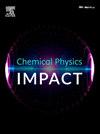正极材料锂过渡正硅酸盐Li2FexMn1-xSiO4的合成与表征
IF 4.3
Q2 CHEMISTRY, PHYSICAL
引用次数: 0
摘要
最近,锂金属正硅酸盐 Li2FeSiO4 和 Li2MnSiO4 作为锂离子电池的正极材料备受关注。本文采用溶胶-凝胶法合成了 Li2FexMn1-xSiO4 (x = 0.3, 0.5, 0.7) 正极材料,并通过 X 射线衍射 (XRD)、场发射扫描电子显微镜 (FESEM) 和能量色散 X 射线 (EDX) 对其进行了物理表征。场发射扫描电子显微镜图像确认了纳米级的立方体颗粒。EDX 图谱显示了不同样品中铁、锰和硅酸盐的存在。锂离子电池由凝胶聚合物电解质 PVdF-HFP/LiClO4/EC-PC、Li2FexMn1-xSiO4(x=0.3、0.5、0.7)阴极和石墨阳极组装而成。通过循环伏安法(CV)和电静态充放电(GCD)技术对组装好的电池进行了电化学表征。据观察,电池的氧化峰和还原峰随着扫描速率的增加而移动,这表明电荷转移是在界面上扩散控制的。锂2Fe0.5Mn0.5SiO4/石墨电池在 1 mA cm-2 时的放电容量最高可达 220 mAh g-1。本文章由计算机程序翻译,如有差异,请以英文原文为准。

Synthesis and characterization of lithium transition orthosilicates Li2FexMn1-xSiO4 as cathode material
Recently, lithium metal orthosilicates Li2FeSiO4 and Li2MnSiO4 are attracted attention as a cathode material for Li-ion batteries. Here, Li2FexMn1-xSiO4 (x = 0.3, 0.5, 0.7) cathode materials are synthesized by using sol-gel method, and physically characterized via X-ray diffraction (XRD), Field emission scanning electron microscopy (FESEM), and Energy dispersive X-ray (EDX). The FESEM images confirm the cubical shape particles in nanometers scale. The EDX mapping indicates the presence of iron, manganese, and silicates in different samples. The Li-ion batteries are assembled with gel polymer electrolyte PVdF-HFP/LiClO4/EC-PC, and Li2FexMn1-xSiO4 (x=0.3, 0.5, 0.7) cathode and graphite anode. The assembled cells are electrochemically characterized by cyclic voltammetry (CV), and galvanostatic charge-discharge (GCD) techniques. It is observed that the oxidation and reduction peaks of the cells shifted as scan rate increases which indicate the charge transfers are diffusion controlled at the interface. The cell Li2Fe0.5Mn0.5SiO4//graphite offers highest discharge capacity∼220 mAh g−1 at 1 mA cm−2.
求助全文
通过发布文献求助,成功后即可免费获取论文全文。
去求助
来源期刊

Chemical Physics Impact
Materials Science-Materials Science (miscellaneous)
CiteScore
2.60
自引率
0.00%
发文量
65
审稿时长
46 days
 求助内容:
求助内容: 应助结果提醒方式:
应助结果提醒方式:


